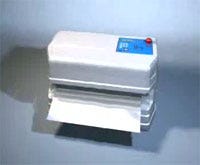October 15, 2008
Originally Published MPMN October 2008
BREAKTHROUGHS
In-Process Inspection, Testing Prevent Pouch Failures
|
Low-angle-of-light 3×-magnification VIU module enables visual inspection of seals. |
Quality assurance breaches such as pouch failures often occur because medical device manufacturers do not inspect and test packages regularly. That’s the viewpoint of Charlie Webb, package engineer and certified managing consultant for Van der Stähl Scientific Inc., a provider of medical packaging machines. To prevent costly failures, the company has spent nearly 10 years developing a system that performs in-process testing at the point of packaging.
“When new medical device companies ask us how we recommend keeping their validation program on track, we repeatedly answer: ‘Inspect and test your pouches often,’” notes Webb. “Too many companies rely on sealing machine alarm functions…. We have seen far too many companies contact us ex post facto about a packaging failure.”
In partnership with Fuji Impulse, the company has designed the MS-451PV, a sealing machine that prompts the operator to perform an ASTM F-88 peel study. If the pouch performs as expected based on the quality team’s minimum seal-strength threshold, the sealer will continue to operate and store the data in its memory. If the seal fails, the machine prevents further operations until quality specialists can determine the cause of the failure. The machine is designed to seal Tyvek and clear-film packages, but it can also be used in foil packaging and clear-film-to-clear-film applications.
“Customers who have been asking about this product seem to be companies that have already experienced a failure in their packaging program and that possibly received an [FDA] 483 due to a breakdown in their sterile packaging process,” Webb says. The system ensures seal-to-seal consistency and helps to prevent packaging breaches by controlling critical parameters such as platen pressure and the platen’s thermal environment. It also incorporates the VIU module, a low-angle-of-light 3× magnification unit that enables operators to perform nondestructive visual inspection of seals for pleats, wrinkles, fissures, or channels.
“Too many companies have taken a due diligence approach to their validations. They create a huge pile of paperwork at the outset and are very thorough about their initial work,” concludes Webb. “However, if the true aim is to ensure that our devices maintain their sterility to the point of use, then we need to look at ways to regularly inspect, easily automate and mechanize this function, and store and record the data that we gather.”
Van der Stähl Scientific Inc., Wrightwood, CA
www.vanderstahl.com
Copyright ©2008 Medical Product Manufacturing News
You May Also Like





